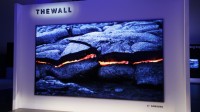Samsung, LG, Others Advancing MicroLED TV Screen Tech
February 8, 2019
Samsung has been demonstrated MicroLED wall-sized TV screens at the last two CES confabs in Las Vegas. Dubbed The Wall, the screen comes in a gigantic version at 219 inches and, now, a smaller one at 75 inches. The latter is only a prototype, but the 146-inch version is for sale, for a price that depends on installation costs. The last new screen technology to be debuted was OLED, on Sony XEL-1 TVs in 2008. OLED now dominates high quality images on TVs and most high-end smartphones, although there are plenty of older LCD screens to be found.
CNET reports that Samsung isn’t the only company that’s in the push for MicroLED screens, having been joined by LG, which “showed a demo panel at the IFA show in Berlin, while Chinese TV giant TCL had a MicroLED TV in its booth at CES 2019.” It adds that, “Sony has been working on some variation of direct LED TVs since as early as 2012, and both it and Samsung showed similar technology for movie theaters and other huge-screen commercial uses.”

With regard to cellphones, Apple now uses OLED displays on its pricier iPhones and Apple Watch, “but it’s reportedly developing its own in-house MicroLED displays for use in mobile devices, starting with the watch.”
MicroLED is interesting because it “has the potential for the same perfect black levels as OLED with no danger of burn-in … can deliver higher brightness than any current display technology, wide-gamut excellent color and doesn’t suffer the viewing angle and uniformity issues of LCD.” The hurdle is manufacturing, with sources saying that the screens are so much more difficult to produce than OLED screens that “Apple almost pulled out of development a year ago.”
MicroLED is made up of tiny LEDs: 25 million of them, one for each pixel for a 4K 3,840×2,160 display. The problem is that “when you shrink LEDs, the total amount of light they produce goes down.” Driving them harder means “the TV will need a lot more electricity and have to dissipate a lot more heat.” Reducing the pitch size (the gap between pixels) is also difficult because, “the circuitry and other necessary elements can only get so small.”
That limits how small a MicroLED can be, making Samsung’s 75-inch prototype impressive — and offering a serious challenge to the production of a more commercially viable 50-inch screen.
MicroLED TV doesn’t only produce brighter images and perfect black, but, in theory at least, will provide wider viewing angles with less or no motion blur, no image retention or burn-in and a longer lifespan than LCD or OLED TVs currently available. Its modularity also makes it easier to scale the size of displays, with similar production costs for a 4K and 8K TVs.
“If your dream is a wall-size display with 10K resolution, this could be the way to get it,” says CNET. But, with all the technology challenges that commercial production of MicroLED sets pose, consumers will have to be patient.
Related:
QLED vs. OLED TV: What’s the Difference, and Why Does It Matter?, Digital Trends, 2/5/19

No Comments Yet
You can be the first to comment!
Sorry, comments for this entry are closed at this time.